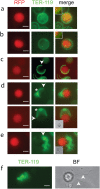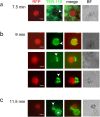Sequential Membrane Rupture and Vesiculation during Plasmodium berghei Gametocyte Egress from the Red Blood Cell
- PMID: 29476099
- PMCID: PMC5824807
- DOI: 10.1038/s41598-018-21801-3
Sequential Membrane Rupture and Vesiculation during Plasmodium berghei Gametocyte Egress from the Red Blood Cell
Abstract
Malaria parasites alternate between intracellular and extracellular stages and successful egress from the host cell is crucial for continuation of the life cycle. We investigated egress of Plasmodium berghei gametocytes, an essential process taking place within a few minutes after uptake of a blood meal by the mosquito. Egress entails the rupture of two membranes surrounding the parasite: the parasitophorous vacuole membrane (PVM), and the red blood cell membrane (RBCM). High-speed video microscopy of 56 events revealed that egress in both genders comprises four well-defined phases, although each event is slightly different. The first phase is swelling of the host cell, followed by rupture and immediate vesiculation of the PVM. These vesicles are extruded through a single stabilized pore of the RBCM, and the latter is subsequently vesiculated releasing the free gametes. The time from PVM vesiculation to completion of egress varies between events. These observations were supported by immunofluorescence microscopy using antibodies against proteins of the RBCM and PVM. The combined results reveal dynamic re-organization of the membranes and the cortical cytoskeleton of the erythrocyte during egress.
Conflict of interest statement
The authors declare no competing interests.
Figures









References
Publication types
MeSH terms
Substances
LinkOut - more resources
Full Text Sources
Other Literature Sources
Medical
Molecular Biology Databases

